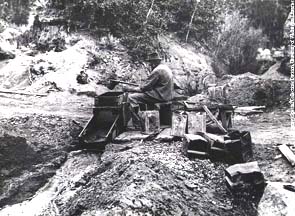James Monroe McCutchen
1834-1922
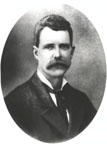 |
||
Stories about James Monroe (JM) McCutchen, birth to marriage
This is a compilation of several versions of the stories passed down through our family. Where the information came from somewhere else besides family stories and traditions, as from a website, I've done my best to give credit to the source. To go to a specific source's website, click on the author's name in the body of this piece. (If the source is not a website, this link will send you to my Resources page.) See this page for full references, including some which are not cited here but were still helpful in my research.
Missouri, 1834-1850
The McCutchens were in Missouri before the Homestead act of 1820 but this allowed them to spread out. In Morgan County alone, there were 15 McCutchen homesteads, taken out between 1831 and 1859.(BLM) Some belonged to James, my great-great-grandfather, some to at least two of my great uncles (James Dean and Robert) and three to my great-grandfather, Alfred. Others belonged to cousins and other McCutchen relatives and to Wears, also relatives. James lived in Cooper county before he homesteaded in Morgan County and moved his family there. His two oldest sons, James Dean and Alfred, started married life in Cooper county and moved to homesteads in Morgan county. See Missouri counties map with homestead locations. Alfred's patents were in 1840, 1848 and 1849. The 1840 patent was with Washington C. McCutchen, not a brother, but maybe a cousin.
My granddad, James Monroe, otherwise known as JM, was the second oldest of Alfred and Mary's 9 children.(Turner) The creekside place where they lived was in the hill country of central Missouri, in Morgan County. Since the family owned at least a couple of slaves and several horses, they were thought of as rich in this place where most people traveled by 'shanks mare'. JM's pa, Alfred, owned a grist mill. People walked for miles, carrying a sack of barley or corn to be ground at the mill. While they waited, they'd catch up on all the local gossip. To know more about operating a gristmill in this time period, go to OSV.
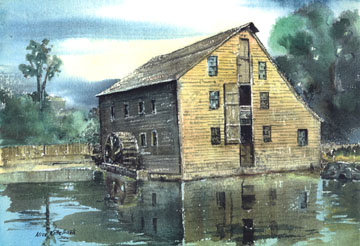 |
A painting of a gristmill, circa 1700, in New York. (Saddlerock) As with the reference above, this painting is not of the McCutchen mill, or even of a mill in Missouri. The McCutchen mill was probably smaller and situated next to a creek. But much more would be similar: the wheel, the water, the room for storing grain and the grinding process. |
Alfred was a Morgan County magistrate, which was about as close to a judge the area could afford. He heard cases of local wrong-doings like theft or assault, made judgments of innocence or guilt, and handed out punishments as he saw fit. Flogging was the most likely means of punishment; the number of flogs depending upon the severity of the crime. More serious crimes were sent on to places like Jefferson City to be heard by a higher court. To learn more about Morgan County (but, sorry, not magistrates!), go to Baker.
When JM was about 11, his Uncle Bill stopped by on his way West. It was 1846, and he was all fired up about going to Oregon, or maybe California. Uncle Bill was JM's Pa's younger brother. He was tall beanpole of a man, all 6 foot 6 inches of him, in an era when 6 foot was considered very tall. Uncle Bill'd been living in Tennessee but he had a itchy foot. After he married, he moved to Missouri, down Jefferson City way, and after a few years, he started agitating to move further west. His wife finally agreed and here they were, right in JM's house, talking about it. JM wanted to go with him but of course, Pa wouldn't let him. JM couldn't wait until he was old enough to go West too. When word came back, months later, that Uncle Bill had had such bad luck with the group he'd joined, a bunch headed by a guy named Donner, it just added to the JM's interest. The 12 year old boy saw the adventure, not the hardship. (See Stucky to read more about William McCutchen's historic and traumatic trip.)
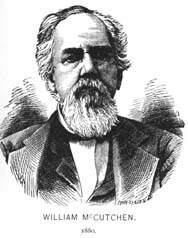 |
William McCutchen, of Donner Party fame in 1880. He JM's uncle. He, His wife, Amanda, and his daughter, Harriet, joined the Donner Party and went to California with it in 1846. They became snowed in and several in the party, including Harriet, died. Big Bill, as he was called was one of two men who walked out for help. (photo: McGlashan) |
When JM was about 14, his mom died, leaving a bunch of kids, mostly girls, including one just born. JM was the second oldest. His Pa married again right soon, like folks did back then. I guess a man couldn't fault him for it. After all, he had a mill to run besides his work as a magistrate. That didn't leave much time to raise 8 kids, with his oldest daughter just 13. His older brother, Cal, was hotheaded, likely to act first and think later. When JM was about 16, Cal got into a fight with a neighbor family and took off for parts unknown, JM just naturally took over the big brother role--he'd been the responsible one all along.
Cal'd only been gone a few weeks when JM ran into a minnie ball. Feelings were still running high cause a boy had been hurt awfully bad in Cal's fight. JM was riding home after church that evening long about sundown, just minding his own business when he saw a fellow at the side of the road up ahead of him jump off his horse. JM didn't think much about it until he saw the guy had his gun out and was taking aim over his saddle. By then it was too late to avoid being hit and the bullet got JM in the leg. JM hightailed out of there without checking to see just who it was who hit him or waiting to see if he was going to shoot again. JM never knew if the man meant to kill but his aim was poor, or if he was only meaning to scare, but strongly suspected the former. JM carried a Minnie ball from that shot in his leg for the rest of his life.
JM, he didn't get along so well with Elizabeth, his step-ma. He missed his ma of course, but it didn't help that Miss Elizabeth, as his Pa made him call her, was only a few years older than he was. JM felt responsible for his sisters and his little brother, but the minnie ball incident made him decide he'd had enough, especially added to all the changes at home, and as soon as he could ride again, he just up and left. His remaining brother, Georgie, wanted to go with him, but he was too young-he was only 8. Some of the girls wanted to go too, but JM figured that, given time, they'd find someone to marry, start raising a family and forget all about it.
Thinking of all the stories Uncle Bill had told, and all the stories he'd heard since, about the gold that had been discovered not long after Uncle Bill got to California, JM headed out west, working his way the first time with a wagon train that headed up at St. Joe, MO. He followed the Oregon Train most of the way, but eventually, he ended up in Montana, following the rumors of gold to be found there. This was in the 1850's, and the west was opening up about this time and gold and silver fever was rampant. He started out as a 'swamper' (wagon driver's assistant), went on to be a 'mule skinner' (the wagon driver) and in general, learned all he could about driving a team of horses (JM always preferred horses to mules) and about the trail between Missouri and the west.
Like many young men with few responsibilities, he tried a
lot of different things and moved on when he felt like it. For instance, he
hired out as a ranch hand in Nevada and that was OK, but what really lit his
flame was driving a team of horses and doing freighting. He liked the horses
and the moving around. With mining towns popping up from South Dakota to California,
there was always a need for teamsters like JM to move stuff between towns
and from sources of supply, like Independence or St. Joe, MO to the mining
towns. These longer runs got JM back home now and then to check on Georgie
and his sisters.
When George turned 16 (and no longer allowed people to call
him Georgie), JM finally gave in and let him tag along. Things weren't so
great at home. Miss Elizabeth had been having babies about once a year, but
most of them didn't live. Taking care of herself and the younger ones was
about all she could handle. The older ones were pretty much on their own.
Tennessee and Lou Ann both did as JM predicted and caught themselves a man,
but Mary Jane was still single at 21 and begging to go along when JM and George
left to go west.
JM wasn't planning on being responsible for any young single girl out west, no siree. He knew that having her around would cramp his style for sure. He told her that the wild mining camps where he hung out when he wasn't on the road were no place for a woman alone. He told her she surely couldn't come along with him on his freight runs, and face everything from the elements to the outlaws. And he made it stick until after the Civil War.
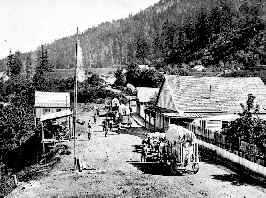 |
Freight wagons going through a small western community similar to those
that JM's freighting company served from about 1850 to 1880. |
JM and George started up a freighting company based in Montana. The freighting company had had 3 wagons. Each wagon had 10 span of oxen, (like a 20 mule team, only oxen?) one driver and one swamper. They freighted back and forth between Missouri, Nevada, and Virginia City, MT and, at least once, as far north as Great Falls, MT. They'd cross Utah, go through Nevada and up into Montana, then back the same way to Missouri. The whole trip took about a month. In some places, hard money was scarce, and they were paid in produce like carrots instead. They took the carrots back to Missouri, or places where fresh vegetables were scarce, like the mining camps in Montana, and sold them. As the Civil War made travel more difficult, the freighters tended to skip the trip back to Missouri and stay in the west.
JM was in Virginia City, Montana, at the time that the Henry Plummer Gang was going strong in the early 1860's, (which was also the time the Civil War started). This gang would have been a special threat to JM's freighting company since they often stopped freight wagons and helped themselves to whatever they could. Law was scarce in the west, so the miners took matters in their own hands and formed a Vigilante Committee. (VCPA). Their methods were effective but JM thought they were way too harsh. In 1864, the committee hung 22 men. Raised with a strong respect for justice, learned from being the son of the local magistrate, JM was critical of the "shoot (or hang) first and ask questions later" mentality of the vigilantes. And history proved him right. Many men hung by the committee were later shown to be innocent. JM never had anything good to say about vigilantes.
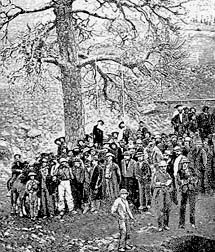 |
Left: Pen and ink drawing of vigilantes at work, from above source. (VCPA) Right: Placer miner in Helena MT, a place JM visited.
He is using a sluice box to wash out the gold --faster and easier than
using a pan, but still messy and wet. |
JM worked a placer mine near Alder Gulch for a while but he found it a hard, dirty job with no sure promise of reward. He said he knew easier ways of gambling! And he found freighting paid better, for sure.
The Civil War, 1860-1865
JM never fought in the Civil War. His brother Cal became
a Confederate soldier but JM's sympathies were with the North. At 26 when
the war started, he was no kid and could easily have been fighting in a battle
where he and his brother where at odds, if he'd stayed in Missouri. But JM'd
been out west for years before the war began and that's where he stayed until
the last year or so of the war. With a Minnie ball in his leg, JM wasn't a
good candidate for a soldier anyway, and besides, he said he "wasn't
mad at anyone". But JM did go back to Missouri and did do freighting
for the Union Army, probably after he quit placer mining at Alder Gulch. He
knew freighting; it was a good alternative option to fighting, and it was
something a guy with a gimpy leg could do. The Union was looking for freighters
to haul gold from the newly organized Montana Territory so it would have funds
to supply the ongoing battle. (Sargent)
Given JM's Northern sympathies, his presence in Montana at that time and his
return to Missouri, it is an easy jump to guess that he freighted Union gold
from Montana to Missouri.
The story goes that JM had delivered his load of freight (gold?) to a Union army base in a part of Missouri where he was well known, and was on his way to get another load when he was picked up by a group of Union soldiers from a camp some distance away. They took him to their camp, locked him up in a stockade and there he sat, accused of being a Southern spy. No one in this camp knew him, and he was a civilian freighter so he wasn't in uniform and the soldiers turned a deaf ear to his complaints of innocence. "This is the Southern spy we're gonna hang at daybreak" the soldiers would tell visitors when they squired them around the camp. His only hope was that before he really was hanged, someone he knew would show up at the camp. Three weeks of 'daybreaks' later, he was still in the blockade, getting more and more worried, when an officer from the camp where he'd delivered his last load of freight recognized him. JM was freed right away with all kinds of apologies. I don't know if he went back for another load of freight before the war ended or not. Alder Gulch only shipped gold for a couple of years (1863-4) right at the end of the war, so this may have been his last trip.
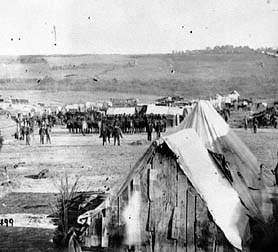
Union Army camp similar to those where JM delivered his freight from Montana
and where he was held prisoner for 3 weeks waiting to be hung at daybreak.(SSE)
After the War, 1865-1870
At the end of the war JM's sister, Mary Jane, was still single and "on the shelf", like many young women in these post war years when young men were so scarce and she was still bugging JM to take her west. Her sister, Lou Ann, and her husband, Robert Green Wear, said they had a hankering to take their small daughter, Anna, and move west. JM gave up and agreed that Mary Jane could go too. The Wears brought along their small daughter, Anna Lee. Montana is a big state and we don't know where the McCutchens and Wears settled first. However, since JM and George continued to run their freighting company, it is likely they stayed near Virginia City, in the southwest portion of the state. However the Wear children eventually settled and raised their own children around and in Miles City, in southeastern Montana.
The Wears added a son, William Edgar, to their family in
1866. (LDS)Mary Jane was living with the Wears
in Montana when she met Ashworth (Sid) Roberson. The story goes that he saw
her walking across the street in the little mining town where she lived, and
he told his buddy, "That's the gal I'm going to marry!" And within
a year he did! They were married in Montana but moved to Elko, NV before
their first child was born. (See Elko for more stories
about Sid.) In 1868, the Wears also moved to Nevada and their last three children
were born there.
Nevada history books (Patterson) say JM McCutchen was a settler in the Mound Valley area in 1869. At that time, JM and his brother George continued to run their freighting line, with George based in Montana and JM in Nevada. In 1870, George became very ill and died of pneumonia. He was only 27 and he never married. JM ran the line alone after that, although, without George to head up the northern end of the route, his wagons seldom got to Montana anymore. In 1879, JM met Mary Landon in Nevada and they were married in 1880. (see Landon for Mary's family history, the story of her trip west and the meeting between JM and Mary. See Elko for the story of the couple's early married life in Nevada.)
